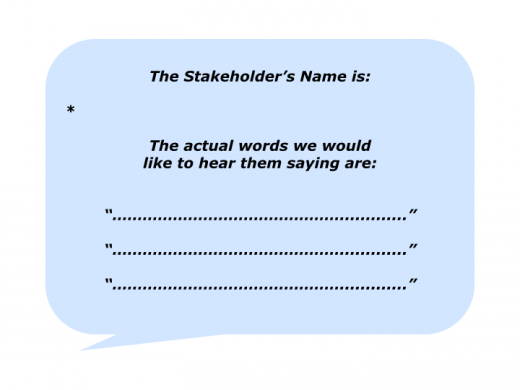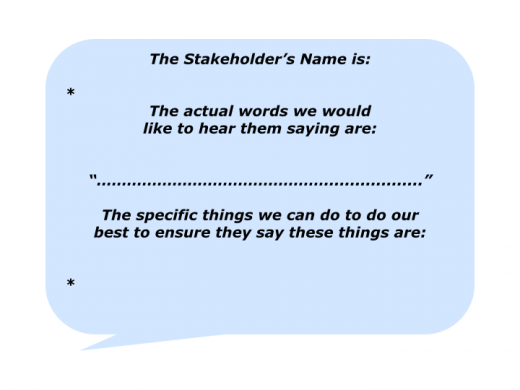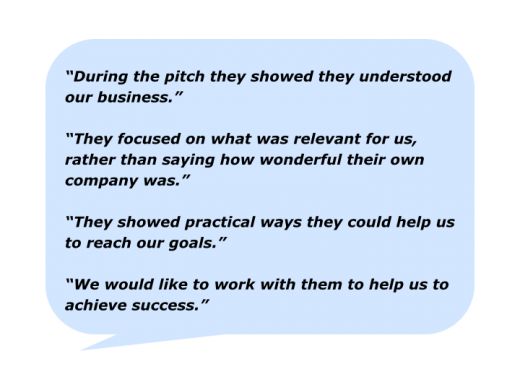
Imagine that you have taken over a team. They will obviously need to provide great service to their customers.
They will also need to satisfy their internal stakeholders – such as their managers or head office. People sometimes fall down on this aspect. They can get wrapped up in processes or criticise other departments.
Great service givers, however, realise that: “People buy success, they don’t buy the theory of success.”
So it is vital that they deliver success to both their internal and external stakeholders. There are many ways to encourage people to make this happen.
One approach is to get the team members to clarify the actual words they want to hear key stakeholders saying in the future. People can then do everything possible to achieve the picture of success.
Let’s explore how you may want to do this exercise when taking over the team.
Clarifying the actual words you would
like to hear the stakeholders saying
This exercise adds an emotional element to goal setting. In addition to setting economic targets, it describes what the team would like people to feel after their interactions with them. As Maya Angelou said:
“People will never forget how you made them feel.”
Many educators use this type of exercise when designing team workshops. They meet with the key stakeholders ahead of time and ask:
“What do we want people in your team to be feeling, thinking, saying and doing after the session?”
The stakeholders may want to hear the team members saying, for example:
“That was an enjoyable workshop. We now know where the team is heading.”
“We know the team’s strategy – plus the reasons for taking this direction – and we want to work towards achieving the goal.”
“We know our parts in making the strategy happen and how we can get some quick successes.”
Sales teams sometimes follow a similar approach before pitching for business. They clarify what they want the decision makers to be saying after they have made their presentation. Their answers may include the potential customers saying some of the following things.
Imagine you are working with your new team. You can invite them to go through the following steps to achieve success.
People can brainstorm their key stakeholders
and write the actual names of these people
The internal stakeholders will include the managers to whom they report and other key people in the organisation. It is vital to deliver the goods to these people – otherwise life can be difficult.
The external stakeholders will include all their customers. They can write the actual names of key people within each of these accounts. Again, it will be vital to deliver success to these people.
People can refine the list, allocate one flip chart per stakeholder
and write the name of the stakeholder at the top of the flip chart
Some time ago I ran a session for 30 people in a pioneering company. They identified several groups of stakeholders.
These included: The Potential Buyers; The Venture Capitalists; John, The CEO; Sue, The Managing Director; The Customers – these were broken down into long-term customers, new customers and prospective customers; The Colleagues – the people working in the company.
Your team will have its own list of stakeholders. Once these have been established, you can invite people to take the next step.
People can describe the actual words they would
like to hear each of the stakeholders saying
Invite people to go to the flip chart that relates to the specific stakeholder they would like to focus on. You can encourage people:
To brainstorm and then agree on the actual words they would like to hear the specific stakeholder saying.
To make sure these are actual sentences – rather than management phrases – and to bring the sentences to life by giving examples.
For instance, for one of their managers to say:
“The team has got its act together. They keep me informed about their progress towards achieving the goals. There are no surprises, so I don’t have to worry about them.
“They got some early wins, which was reassuring. They also embody the company’s values in the way they do business.”
Let’s assume that the team members have completed this stage. They can then move on to the next step.
People can describe the specific things they can do to do
their best to ensure the stakeholders are saying these things
People can only do their best, of course, and focus on the things they can control. They can, for example, aim:
To clarify the stakeholder’s picture of success.
To clarify the Dos and Don’ts for working well with the stakeholder.
To be positive, professional and make clear contracts regarding what they will deliver – and when – for the stakeholder.
To provide great service and proactively inform the stakeholder about the progress towards achieving the goals.
To, when appropriate, present possible solutions to challenges.
To continually clarify: a) What they are doing well regarding the service they are providing and how they can do more of these things; b) What they can do better in the future and how.
To continually improve their professional offering and do what they can to help the stakeholder achieve success.
Different teams use this exercise in different ways. Some complete the flip charts and then put them around their work place. Others use them as wallpaper for their computers.
Great service givers keep referring to these aims. They then do their best to ensure their stakeholders are saying the desired things.
Here is the final exercise you can give the team. Invite them to complete the following flip chart and focus on doing these things to help each of their stakeholders to achieve success.








Leave a Reply